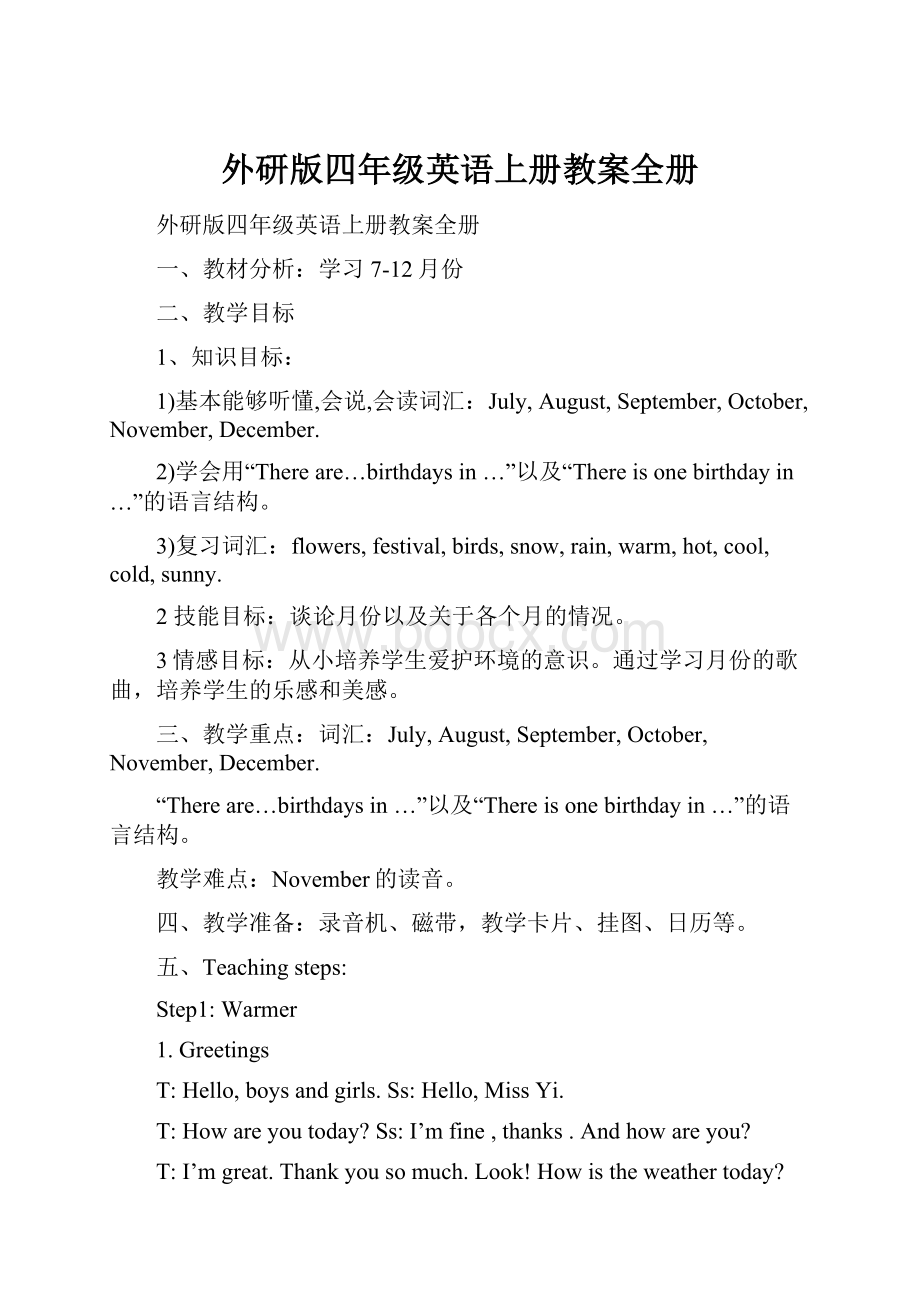外研版四年级英语上册教案全册.docx
《外研版四年级英语上册教案全册.docx》由会员分享,可在线阅读,更多相关《外研版四年级英语上册教案全册.docx(13页珍藏版)》请在冰豆网上搜索。

外研版四年级英语上册教案全册
外研版四年级英语上册教案全册
一、教材分析:
学习7-12月份
二、教学目标
1、知识目标:
1)基本能够听懂,会说,会读词汇:
July,August,September,October,November,December.
2)学会用“Thereare…birthdaysin…”以及“Thereisonebirthdayin…”的语言结构。
3)复习词汇:
flowers,festival,birds,snow,rain,warm,hot,cool,cold,sunny.
2技能目标:
谈论月份以及关于各个月的情况。
3情感目标:
从小培养学生爱护环境的意识。
通过学习月份的歌曲,培养学生的乐感和美感。
三、教学重点:
词汇:
July,August,September,October,November,December.
“Thereare…birthdaysin…”以及“Thereisonebirthdayin…”的语言结构。
教学难点:
November的读音。
四、教学准备:
录音机、磁带,教学卡片、挂图、日历等。
五、Teachingsteps:
Step1:
Warmer
1.Greetings
T:
Hello,boysandgirls.Ss:
Hello,MissYi.
T:
Howareyoutoday?
Ss:
I’mfine,thanks.Andhowareyou?
T:
I’mgreat.Thankyousomuch.Look!
Howistheweathertoday?
Ss:
It’ssunnytoday.
T:
Howdoyoufeelnow?
Areyouhappy?
Ss:
Yes.We’resohappy.
T:
Let’ssingasong,ok?
Ss:
OK!
T&Ss:
Springiswarm,springiswarm.
Summerishot,summerishot.
Autumniscool,autumniscool.
Winteriscold,winteriscold.
2.复习1-6月份的英文。
Step2:
Presentation
1、Leadin
T:
Howmanymonthsarethereinayear?
Ss:
Therearetwelvemonthsintheyear.(引出课题)
板书:
Unit2Therearetwelvemonthsintheyear.
T:
Let’spassthetoydogandsaythewordsfromJanuarytoDecember.
Ss:
January,February,March,April,May,June….接着老师带着学生一起说:
July,August,September,October,NovemberandDecember.(在游戏的过程中引入新单词)
T:
Today,we’regoingtolearnthemonths.
2、教授—July
T:
Boysandgirls,let’splayagame,ok?
Ss:
OK!
T:
Iwillspeakthesenamesofthemonths.Andyoucanshowmeyourfingerstoshow.Ss:
Yes.
T:
May.Ss:
(showfivefingers)May.
T:
March.Ss:
(showthreefingers)March.
T:
July.提示学生showsevenfingers.(July)
T:
DoyoulikeJuly?
S1:
Yes.IlikeJuly.WecangototheparkinJuly.
3、教授—August
T:
Howoldareyou?
Ss:
I’m10yearsold.
T:
Whenisyourbirthday?
Ss:
八月。
T:
Oh,yourbirthdayisinAugust.WhosebirthdayisalsoinAugust?
S2:
MybirthdayisinAugust,too.
T:
HowmanybirthdaysarethereinAugust?
Ss:
Thereare….
4、教授--September
T:
Boysandgirls,whenisTeacher’sDay?
Whocantellme?
S3:
九月十日。
T:
You’resoclever.September,10th.DoyoulikeSeptember?
S4:
Yes.IlikeSeptember.
T:
Whatcanyoudo?
S5:
Wecangotoschool.
T:
Soundsgreat.
5、教授—October
T:
Youcanguesssowell.Doyouknowwhichmonthitis?
“It’scoolandit’sinAutumn.Thereare31daysinit.AndthereisNationalDay,too.”
S6:
October.
T:
Yes,youareright.
6、教授—November
T:
IlikeNovember.Whatdoyoulike?
S7:
IlikeJune.
S8:
IlikeMarch.
T:
DoyoulikeNovember?
Ss:
Yes,welikeNovember.
7、教授—December
T:
Oh,I’maweatherreporternow.InBeijing,it’scoldandthereissnowinDecember.(播报天气预报)Canyouhearwhichmonthitis?
Ss:
十二月。
T:
December.WhosebirthdayisinDecember?
S9:
MybirthdayisinDecember.
T:
HowmanybirthdaysarethereinDecember?
Let’scount.
Ss:
Thereare….birthdaysinDecember.
T:
IheardMsSmartarecountingbirthdaysnow.Pleaselistentothetape.
Step3:
Practice
1.Listenanddo.
T:
Boysandgirls,pleaselistenanddo.
T:
1)WhosebirthdayisinJuly?
PleaseStandup.
2)WhosebirthdayisinAugust?
Putyourhandsonyourhead,please!
3)WhosebirthdayisinSeptember?
Touchyourears,please!
4)WhosebirthdayisinOctober?
Clap,please!
5)WhosebirthdayisinNovember?
Pointtotheteacher,please!
6)WhosebirthdayisinDecember?
Laugh,please!
2.Groupwork
完成课本活动3:
先请几个学生朗读对话示例,然后把学生分成小组,让他们根据图中给的信息展开对话,发表自己对各个月份的看法。
e.g.S1:
DoyoulikeJanuary?
S2:
Yes,IlikeJanuary.
S1:
Why?
S2:
Therearelotsoffestivals.
S3:
Whichmonthdoyoulike?
S4:
IlikeOctober.
S3:
Why?
S4:
Wecanflykites.
S5:
Whichmonthisyourfavourite?
S6:
MyfavouritemonthisJune.
S5:
Why?
S6:
It’swarm.Icanrideabike
Homework:
1熟记1-12月份的单词
2、询问父母,然后在课堂上互相介绍自己父母的情况。
外研版四年级英语上册教案全册2:
Thereisonebirthdayinmay
内容分析:
本课是新标准英语(三年级起始)第三册第十模块,它的语言功能主要是运用Therebe句型去描述与月份相关的事情。
第一单元以故事情境——Lingling与MsSmart谈论玲玲朋友生日个数的对话呈现,主要是在巩固Therebe句型的同时学习1——6月份的表达方式。
第二单元则是继续描述7——12月份生日个数的情况,并谈论全年不同月份当地的天气状况以及喜欢的运动。
本模块预计四课时完成,本课时为第一课时。
情况分析:
(1)四年级的学生接触英语已有一年之久,对英语学习的积极性与参与性较高,好动好胜,喜爱小组比赛。
同时他们在认读和自学方面比起三年级均有一定程度的提高,能够听音指读、听音选择、听音填空等,能够认读基本单词,并能借助图文了解课文大意。
(2)在本学期第一模块学生已经学习了数词1—100,对于Howmany?
Therebe句型在听力方面也有感知与理解。
同时,课文中的单词march,birthday,happy等词语学生比较熟悉,结合对话语境能够较快理解课文的背景。
教学目标:
(1)知识能力目标
①能够寻找单词中发音相同的字母组合,以旧带新,听懂、辨别并认读1—6月份的月名,January\February\March\April\May\June。
②能够在倾听完整语篇情境中看图了解对话内容,并了解、运用Therebe句型描述数量。
如,January.Therearethree.
(2)情感态度目标
①培养学生对所学英语中接触的外国文化知识的兴趣。
②让学生通过课文的学习感受生日聚会的快乐,并能在自己快乐的同时表达对父母的爱。
教学重点:
(1)单词:
January\February\March\April\May\June
(2)句型:
“Therebe”功能句的简单运用
教学难点:
(1)单词:
January和February单词比较长,记忆比较难;而April\June则是发音难点。
(2)Thereis和Thereare学生对单数复数概念模糊,容易搞错。
教学过程:
一、Warmer
1、PlayaGame:
Countcountcount数数看
TclapshandsandasksSs“Howmanyarethere?
”
Sslisten,countandtrytosaythenumberorthesentence“Thereis/are…”
【设计意图:
用老师拍手,学生数数的活动作为热身,既能复习数字,又能在听力方面不断倾听句型Therebe,为学生在听后运用句型Thereis/Thereare做铺垫。
】
2、Leadintheevaluation
(1)Putupthecardsofthemonths(出示1—6个月的月份卡,排成桥型),letSscountthecardsandlearntosay“Thereis/are…”;(板书主要句型于黑板四线格上,并用不同色粉笔突出is和are)
Sscountandlearntosayandmakeout“Thereis”and“Thereare”
(2)Talkabouttheevaluation——分组PK
【设计意图:
巧妙呈现本节课的课堂评价方式:
把月份卡(六个月份名的缩写制作成椭圆形卡片)排成桥形贴在黑板上,把全班分成两个小组,要求各小组通过课堂上的表现力争尽快从此岸到达彼岸。
同时,通过月份卡的呈现,引导学生数数,并学习运用句型Therebe准确描述。
】
二、Leadin
1、Leadin
T:
We’recountingjustnow.Linglingiscounting,too.Sheiscountingherfriends’birthdays.
PresentthepictureofLingling’scountingbyCAI
【设计意图:
由我们自己的数数活动过渡到玲玲的数生日的事情,直接导入课文,简单明了,切中本节课的对话背景。
】
2、Listen,readandfindtheanswer
AskSsaquestionaboutLingling’scounting——“Howmanybirthdaysarethereinayear?
”,andletSsopentheirbooks,thenplaysthetape
Ssreadthebook,listentothewholelessonandtrytofindtheanswer
【设计意图:
通过整体语篇的听力输入,要求学生们速听速读课文,整体感知对话情境,进而思考回答问题。
培养学生认真倾听,认读思考的良好自学习惯。
】
3、PresenttheTopic
ShowPictureTwotoSsandpresentthetaskofthismodule
Readthetitletogether:
——Module10TheMonths
Unit1ThereisonebirthdayinMay.
S三、PresentationandPractice
1、Listenandfillintheblanks
AskSsthequestionsaboutPictureTwo——“HowmanybirthdaysarethereinJanuary/February/March/April/May/June?
”
Sslistentoeachsentenceandfillintheblanks
《随堂练兵卡》一、听音填空
一月January.Thereare.
二月February.Thereare.
三月March.Thereis.
四月April.Thereare.
五月May.Thereis.
六月June.Thereare.
【设计意图:
抓住课文的重点段落,让学生有针对性地倾听,再通过随堂练兵一听音填空这个听力练习任务,引导学生再次边听边精读课文第二段,完成听力任务,使阅读更具目标性和实效性。
】
2、Learnthemonths
Presentthemonthsofthisexercisepaper(《随堂练兵卡》)byCAIandaskSs“哪个月份生日个数最少?
”
Ssreadthepaper(《随堂练兵卡》)andfindout——March/May,thenlearntogether
(1)Presenttheword,thephoneticsymbolandthecalendarfromCAI,thenListenitspronunciation
(2)ReadthewordbysyllablesandthenreadafterT
读单词的方法:
小组开火车读,大小声读,男女生读
Game:
四面开花(请一个学生起来读单词,接着此学生前后左右的学生紧跟着读。
看一看哪个学生反应慢,必须再次接受处罚:
独自读单词三遍。
)
(3)Thesamewaytolearnthenamesoftheothermonths通过提问“哪个月份生日个数最多?
”“哪两个月份名称类似”等等逐一呈现剩下的月份名并学习
(4)Practicethewords——快速反应
老师说节日名称,学生对出月份英语名称;老师说月份如“五月,五月”,学生说出其对应英语名称“May”;反之亦然。
【设计意图:
由针对玲玲朋友生日个数的情况提问继而学习月份名,由浅入深,逐一突破重难点。
在学习新单词的过程中引导学生运用以旧带新(march——March)、比较法(February_——January)、元音音节法来突破发音难点,模仿发音,同时结合各个月份的节日、月份的儿歌来练习记忆单词。
最后让学生谈论自己喜欢的月份,进行巩固拓展。
这种新旧知识滚雪球式的融合形式能充分调动学生积极的情感,变机械和单纯的游戏为情感的表达,回归语言学科教学的本质,让复习操练更具人文性和学科性特点。
】
3、Practice
PlayaGame:
GuessWhichmonth看由来猜月份
PresenttheoriginsofthemonthsbyCAI
Ssreadtheoriginsandguessthemonth
CAI呈现如下。
(1)在罗马传说中,有一位名叫雅努斯的守护神,生有先后两张脸,一张回顾过去,一张要眺望未来。
人们认为选择他的名字作为除旧迎新的月名,很有意义。
——January
(2)这个月份正是大地回春,鲜花初绽的美好季节。
由拉丁文“开花的日子”演变而来。
——April
【设计意图:
借助外国文化知识的渗透点燃学生对月份学习的兴趣。
让学生在饶有趣味的猜测中复习巩固月份单词,同时月份由来更作为课堂知识的课外延伸,达到课已尽、学无涯的目的。
】
4、ReadthedialogueofPictureTwo
ReadPictureTwoofthelessonaftertheCD—Rom
Readbythemselves
四、ExtensiveReading
1、Presenttheform,askandanswer
PresenttheformofthebirthdaysfromJanuarytoJuneinclass,askSstodescribeit
出示一张课前老师调查的关于班级上1—6月份同学生日个数的统计表格,让学生看表格描述
2、Practiceinpairs
Ssreadtheformanddescribewithpartners
【设计意图:
语言的学习主要在于运用。
在理解课文的基础上联系生活,让学生在真实自然的任务型活动中拓展运用阅读信息,补充阅读材料,让学生有话可说,提高阅读能力和语言表达能力。
】
五、Sum-up
Sumupthelessonandexpendtotheemotioneducation——Don’tforgettoexpressourlovetoparentsonourbirthdays.Andthenfinishtheblackboardwriting.
六、Homework
两种不同的作业供学生根据自己的需求和能力去选择完成。
★继续完成调查表的内容,用Thereis/Thereare句型描述班上1-6月份生日的人数,并尝试仿写句子。
如January.Thereareeight.
★★请你运用Thereare句型描述1——6月份的天数,并尝试把句子写下来。
外研版四年级英语上册教案全册3:
Didyoubreakyourtoy?
教学目标:
运用过去时态的句子。
在句型中操练达到熟悉程度上,培养学生的口语交际能力。
在反馈练习中,培养学生独立分析和解决问题的能力。
重点难点:
理解并运用过去时态的句子,用它来表达过去的事。
学生分析:
小学生学习一般靠直觉和体验,不善于把握语言规律,对老师依赖性强,而且以直观的形象思维为主,对语言的记忆以机械记忆占大多数,加之学生生源复杂,在英语方面的基础差别很大,这就要求教师选择适合的方法,让学生乐于并易于接受。
教法学法:
讲读、直观演示、交际、愉快教学相结合的方法;
教学过程:
一、课前准备。
(Warming—up)
1、师生互致问候。
2、师生同唱歌曲。
〖设计意图〗通过欢快的歌曲,活跃课堂气氛,调动学生学习的积极性,为后面的任务活动做铺垫。
二、复习导入(Presentation)
1、通过教学课件来复习所学动词及过去式,并用他们来造句子。
2、接龙问答。
Whatdidyoudoyesterday?
三、新知呈现
通过猜教师昨天买了什么来引出新课。
Whatdidyoudoyesterday?
S1:
Youwenttothepark.
S:
Youwenttothemarket.S:
„„
T:
es,Iwenttothesupermarket
leaseguess,hatdidtheteacherbuy?
S:
Youbought„„。
Thatisright.youareclever.youwanttoknowwhatdidourfriendsdoyesterday?
et`slisten.
四、新语言知识学习。
(Study)
1、新词的学习
(1)结合光盘听录音。
(2)结合问题来理解课文Didyoubreakyourtoy?
//Didyouseeascarything?
(3)学习新词scarybreakfall
(4)教师结合动作领读。
(5)小组合作学习:
总结句子构成方法。
一般过去时疑问句:
Did+主语+V„„?
Yes,主语+V。
No,主语+didn’t.
2、对话的学习及运用
(1)连词组句you、Did、fallsee、a、you、did、scary、thingI、yes、didNo、did、Inot
(2)BINGO游戏。
五、任务活动。
(Follow-onActivity)
1、运用所学的过去式的句子提问及回答,调查同学们的活动。
S1:
Whatdidyoudoyesterday?
S2:
Iwenttothezoo.Whatdidyoudo?
S1:
Iplayedfootballwithmyfather.
2、学生反馈
3、学生互评:
哪组同学说的好?
为什么?
引出对话中的礼貌用语